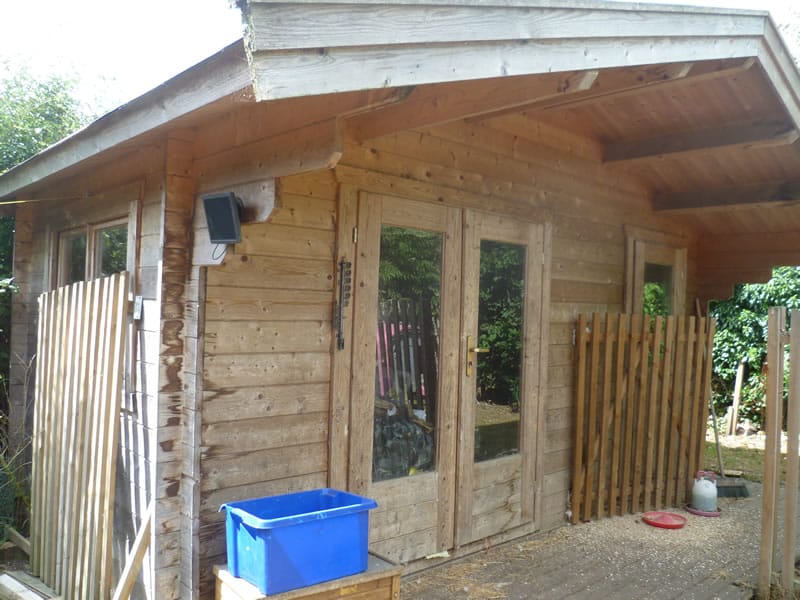Posted
This article is soooooo long but I had to read it all because every bit of it answered questions for me that no-one else has ever been able to - so take it in instalments if necessary
You’ve got your brand new log cabin. It’s up and it’s chucking it down, it’s January 2014 with record rainfall, floods everywhere and your poor log cabin is bare wood, soaked, you’ve got to treat it haven’t you? – PANIC!
NO you haven’t. There is no panic whatsoever! So wait a little while, relax, stop worrying about her, she’ll be fine for years!
This log cabin belongs to a friend of mine I supplied from Tuindeco years ago, apparently, after 12 years she’s still deciding on the right colour! Girls!
Look at the state of the poor old thing, very neglected and unloved it would seem but it’s home to chickens on the veranda and guinea pigs inside during the winter and very much loved and used so she tells me.
I do despair, just look at it! But the point of this is that it is not rotting and it’s still a very solid untreated log cabin.
I’ve asked her to keep leaving the choice of colour until later just so I can see what happens, I hope to post again in ten years when it’s still standing and knowing her she’ll still be pondering the right colour!
Yes the poor ol’ thing has her problems. You can see in this picture how dry the timber is, it’s cracking and shrinking. These pictures were taken last summer so she will look different now. See a post on cracking and splitting in timber for a little more insight into what is going on with timber cracks.
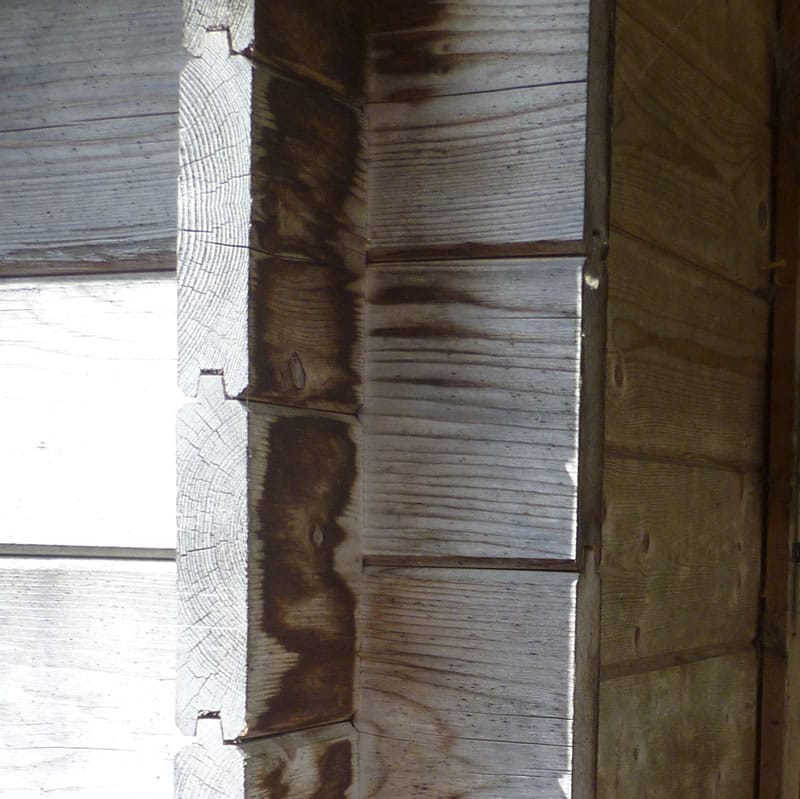
Cracking and splitting of log cabin logs
She’s got one or two more problems as well. Nothing insurmountable though, for instance, this log cabin has a few friends:
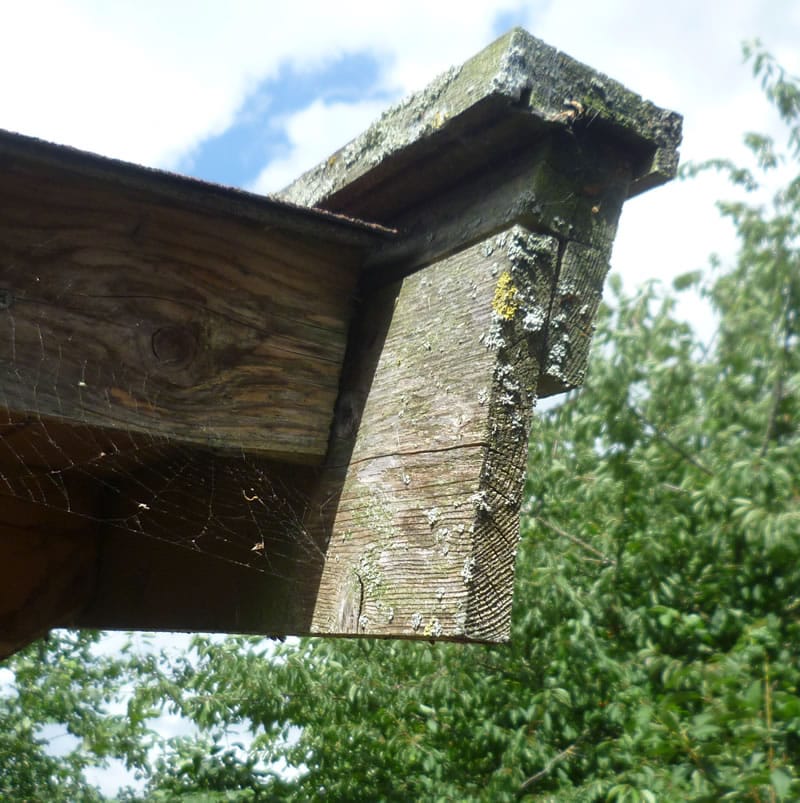
This log cabin is suffering with mould and fungus.
Yup, it does have a little fungus on it. It’s not dry rot as it is way below a moisture content of 20% and never at a steady temperature of 23 degrees which both conditions needs to exist for dry rot to occur. It’s just good friends and they like each other, no harm done.
Here’s another friend:
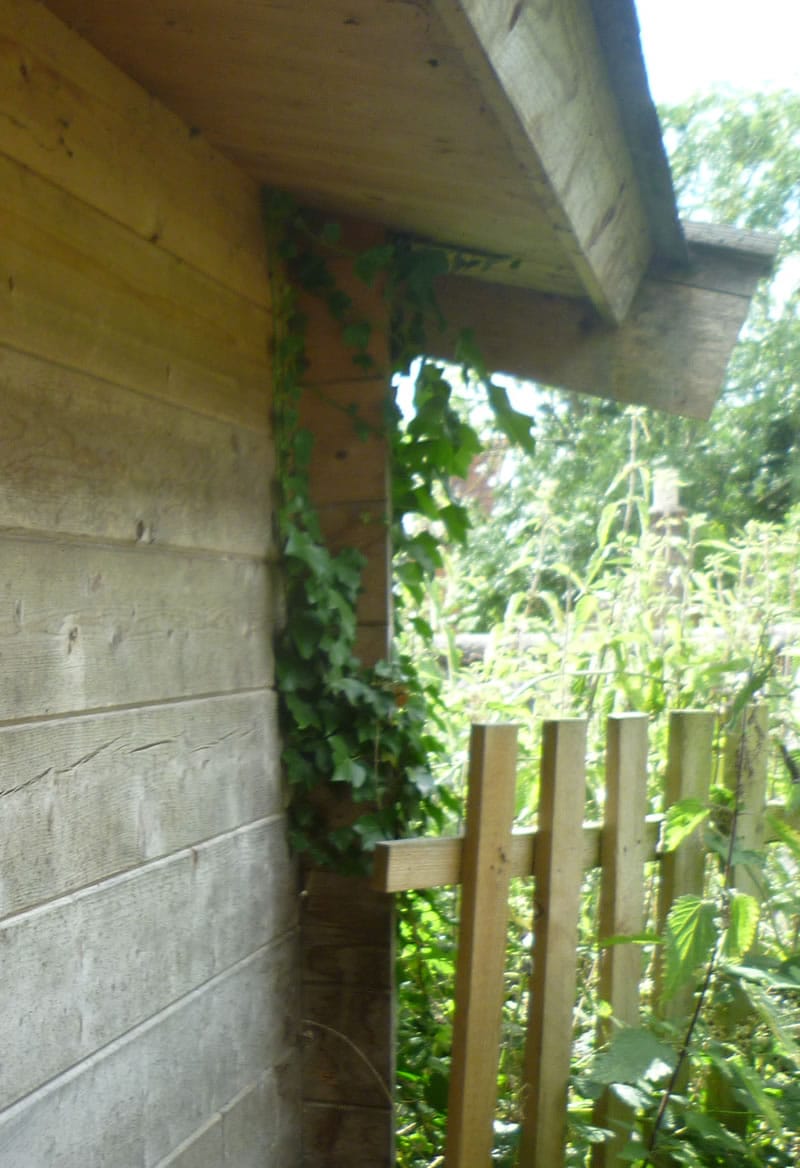
Another friend attaching itself to an old log cabin
The back wall of this log cabin is covered by a hedge, it’s never been cut and now Ivy is growing over it. Goodness know’s the out come if this but the old girl is still going strong and fully in-contact with a hedge and all sorts of undergrowth.
Overall though she’s jolly good. For a log cabin of this age, no treatment ever she’s still solid and displays no rot at all. Here’s the doors and Roof Purlins:
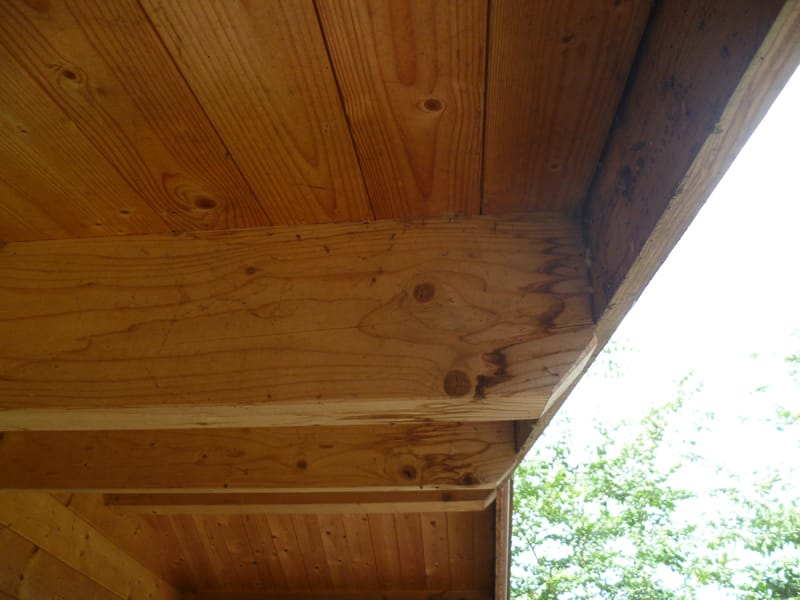
Untreated purlins on a very old log cabin
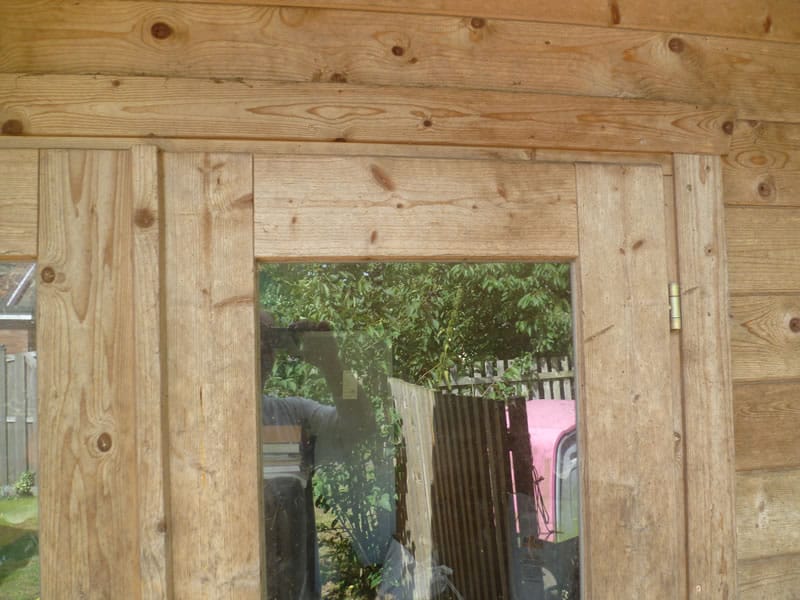
Untreated doors on a log cabin
We give a ten year guarantee on our logs cabins, there’s conditions and they have to be treated regularly blah, blah. If it was up to me I’d give a twenty year one and no treatment. It’s impossible for timber to rot!
Ok, maybe that’s a stupid thing to say, I’ll add a note to it: It’s impossible for timber to rot AS LONG as it is always VENTILATED and allowed to DRY.
So I reckon our guarantee is safe. If you get any rot in 20 years time please let me know and I’ll pay for your replacement out of my own wages. It won’t happen though if she’s allowed to breathe, and, that’s the key with all timber products – ventilation. If it gets wet and it’s allowed to dry out it will NEVER ROT and that’s an inherent property of timber. Not just ours but any timber providing it is timber of a suitable quality for it’s intended use, especially for log cabins watch out for where the timber comes from, slow gown, cold climate etc.
Walter Segal
Just a quick note, I’m a fan of this chap. He’s done a lot for home building and one of his principles was that of timber ventilation with buildings on stilts. If timber is ventilated it will never rot. It’s why I love timber frames as bases for log cabins and I’ve been involved with lots of log cabins on stilts and similar construction methods they all work and never have I had a customer complain of rot.
Log Cabin and Timber Treatment
Of course with all my above whittering and pictures I am not AT ALL advocating not treating your log cabin or any garden timber. It needs it! And you must treat it at some point, the sooner the better
All I’m saying is don’t worry or panic over it, you do have time to do it without worrying if you can’t do it straight way.
If you don’t treat your log cabin or timber you can have a few problems:
- Discolouration of the timber. See the pictures above, she doesn’t look that great.
- Warping and shrinkage of timber. The timber will dry out, warp, distort and will allow the ingress of water and may be pushed out of shape especially if you have an un-level base that it’s sitting on.
- Expansion, the bloomin’ thing wants to reach an equilibrium with it’s surroundings, it wants the same moisture content that is in the atmosphere. So when it’s moist it wants to be moist as well. We can’t have that! The thing is up and down like a yoyo if we let it. If we we let it, cracks will appear which could potentially let the weather in
- As well as the above external pictures, internally, water marks are visible which is unsightly and can / will develop damp spores especially if internally it is not ventilated. Pay attention to this if you are installing a hot tub. The Log Cabin pictured above is always ventilated for the guinea pigs sake and another reason that even though she is not treated she’s still going strong and NOT rotting. This log cabin has a constant flow of fresh air.
- This log cabin is fortunate but insects can attack timber and a good treatment will stop this.
- Attack by UV light causing drying and further splitting. This log cabin is relatively shaded from it with hedges and trees all around, yours may not be.
- Filthy! Yup, she’s a dirty girl, inside and out and this is not something we really want with our very expensive log cabin.
- Weather ingress. Even though it may not rot it will still soak up water and this will percolate through to the inside especially at the corners in an exposed environment.
So, what if it is months before you treat your log cabin?
You can’t treat it straight away? What’s the worst that can happen? Well, it’s this really:
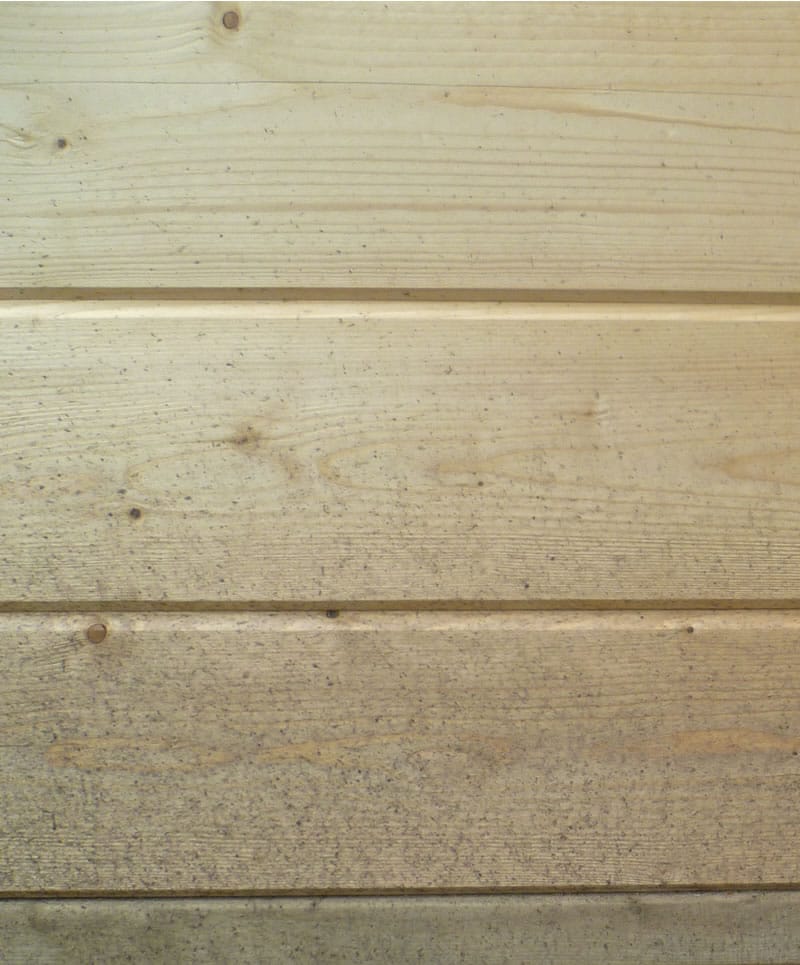
Dirty wall logs on the log cabin
Yup, the poor log cabin gets filthy with rain muck thrown up all over it. When, and if this happens all you need to do is use a pressure washer or a good jet attached to a hose pipe, it comes up like new – honest.
Also, if you find darker marks on it which are a damp fungus forming all you need to do is apply a dilute bleach solution and it will all go and bring the timber back to normal ready for treatment. This will often happen if you’ve left a cabin out in the rain and covered it with plastic while waiting to install it for a month or two. The humidity created is great for a fungus but it’s very easy to remove with a bleach spray and then a wash. Our Sauna display cabin had this after being stacked outside for months, a quick spray and a wash and it’s all gone.
Pressure Washer
Just staying on a pressure washer: I’ve installed log cabins in tempest, storms, gales, snow,hail, in fact every weather condition imaginable. You can’t help to get it dirty inside and out sometimes especially big installs. Just before you hand over to a customer (or yourself) give it a good jet wash or hose down, it’s like new regardless of how messy you’ve made it during the installation.
At the moment we’re installing our show site for the 2014 season, none of the buildings are treated yet and it’s been two months ( three jet washes), we just can’t get a dry day when we can be bothered to paint them (we all hate painting!), but, with a pressure washer they can stay untreated indefinitely. They will never rot, but they will get filthy, we’re getting around to treating them, maybe this weekend? He says hopefully!
Warping and water ingress
Now this is something we are worried about, our show site buildings can’t show anything on the inside and this is a bit of a battle. Timber won’t rot if it’s not treated but it will let in and soak up water. This is regardless weather it has beentanalised or not. To stop ingress we must treat it! Especially if we want it to look good. We also, especially for a show building, don’t want warping of the timber. Did you know a 70mm untreated log cabin can move over four inches a year, we really don’t want this so we have to treat the log cabins on display.
Purpose of a log cabin timber treatment.
I’ve said what happens if we don’t treat a log cabin and that it really is a good idea. So now we are committed to doing it what are we looking for?
- UV protection – we need to protect it from the sun, and the sun and it’s light is a bugger, it’ll dry out timber, cause cracking, distortion and lots more, it’s a real bugger for wood.
- Weather proofing. Wood loves water, it soaks it up, it wants it, it’s a property but we’re meanies and need to keep it below it’s moisture content of 20% and preferably a lot lower. We try to protect it from absorbing water. We try to protect the joints and stopping any water marks from coming through. This is also very important for the doors and windows.
- Reaching an Equilibrium … the bloomin’ thing keeps trying, see this post: Cracking and Splitting in timber. We really don’t want this with our log cabin. Stopping this will save us a lot of time and will make it last for years. Stop the equilibrium I say!
- Creature proofing … Pesky creatures, fungi, worms,etc. A good treatment will stop the pesky critters.
- Elasticity – As I’ve said the thing is moving a lot, even with a good treatment stopping the absorption and shedding of moisture, we need a treatment that can cope with this so high elasticity in also important.
What timber treatment should we use for our Log Cabin?
Hm, now this bit can be a hotbed of law suits. Firstly anything expensive, we only recommend Sikkens, Kingfisher, Sadolins or our own European brands shown in our website or brochure such as Koopmans Embadecor or Embalan and more recently the super treatment from Valvolinn MaxRelease Protectant which is heralded as a revolution in timber treatment and from what I’ve now seen the stuff is amazing
If it’s cheap we (I) don’t recommend it, please don’t be tempted to use anything cheap, any complaints we have had with cracking timber or mould algae etc have always been found to be caused by a cheap treatment, use at your peril but we will not offer any guarantee if you have used it. Expensive is the way forward, you get what you pay for and it’s certainly pertinent when regards to treatment.
When asking a treatment supplier always specify it’s for “Planned, smooth white wood” and let them advise you on the best treatment for that style of timber. Rough sawn treatment is not all compatible.
My old log cabin was painted 15 years ago with Sikkens, all I do is give it a quick wash each year and that’s it:
But, we have this new stuff: MaxRelease.
It can dry in 15 minutes, be painted on wet, clear and still provide UV protection, I’ve even seen it coat grains of sugar in a glass of water and the sugar didn’t dissolve! Clever stuff and now I’ve used it it is amazing, I even tried painting it on wet timber and all the water wicked away as I was painting. Amazing!
MaxRelease Protectant:
With our changing weather conditions our wood / concrete gets a lot to endure rain , sun, wind and frost . To keep your wood / concrete in optimum condition MaxRelease has developed the best protection . The water-borne coatings without organic solvent penetrates into the wood / concrete and thus provides a protective layer against moisture, sunlight , wind and rain for all types of wood and wood products , such as fences , decking , garden furniture , garden poles , log cabins , gazebos , larch and hardwoods , and concrete products such as garden poles and fence systems . It forms a thin layer on the substrate , so that the structure of the wood and the concrete remains pretty visible.
Benefits of MaxRelease Protectant :
- Long-term protection against moisture
- Low maintenance
- Easy to apply and easy to clean
- Excellent colour stability with minimal fading due to sunlight
- Less fungal and algae
- Impregnating
- Corrosion resistant
- Water resistant
- Prevents kalkuitbloei in concrete
MaxRelease Wood Protectant is easy to use . Wood Protectant is a quick-drying material and will dry within 15 minutes ( depending on temperature , humidity, type of substrate ) . There is no primer or other type of primer is not necessary in order to bring . To Wood Protectant This makes the long-term protection of wood and concrete in a simple and quick job . MaxRelease Wood Protectant must be stored frost-free.
Having used this extensively now, I really do recommend it!
Damp Conditions
Regardless what log cabin you buy, from us or anyone there is one treatment that I cannot fail to recommend and this stuff is needed especially if you have a hot tub in your cabin, it’s this: Impregnation Fluid
Now this is clever stuff, it’s a linseed based oil, water soluble and goes on like water when dissolved. It will stop the formation of damp spores and is highly recommended for the inside of a log cabin if it is shut up for months on end or subjected to a damp atmosphere, it’s available in clear, green or brown and in 0.75l or 5l.
Just quickly note on hot tubs, Log Cabins are great as a hot tub enclosure but make sure you use impregnation fluid and also a vent, this also applies if you are storing lots of damp tools.
When do I treat my Log Cabin?
Now this is something I’m asked all of the time. My stock ‘official’ answer as within the brochure and literature is “Always paint / stain / treat your cabin BEFORE installation”
But, oh my goodness that is a real pain, you get paint in the grooves, on the corners and joints, it’s harder to install. You get sticky patches that then get sticky on your fingers, that then leave finger marks on the inside of the logs. It’s a nightmare!
So you’ve had the official answer, the unofficial and only my opinion is just build the cabin and paint it later. In all the years I’ve been doing this I haven’t had a comeback. One hint I would give though is when you come to paint it, remove the top of the door and window fascias and paint behind them, otherwise when it expands, as it will in winter months, you’ll be left with a white line that’ll need painting again. It will never match up so always do it first and beat the sneaky blighter creeping up on you with the annoying equilibrium thing timber does.
How much do I need?
Another question I’m always asked and this one is tricky. It’s all down to the coverage recommended by your chosen brand. But for instance our Perkoleum stain covers 14 – 15 sq.m and the Ecoleum covers 5-8 sq.m. It does vary on the type and brand of paint or stain your are using. It’s best to work out the log cabins dimensions and calculate it and then give this measurement to your supplier, or do what I do and guess and if you run out get some more.
Roof?
I’ve had customers ask about treating the roof. My answer is always why bother? If the final roof covering is applied properly there really is no need.
Summary of wood treatment for Log Cabins
So, in summary what have I said:
- Don’t panic over getting treatment on your log cabin if it’s wet or raining for ages.
- You have a month or two before you need to worry, especially if you have a pressure washer or s jet hose so you can keep in clean
- You do NEED to treat it to make sure it lasts.
- Clean it with a bleach solution for spores or a jet of water for dirt or use Embalit NTK.
- ALWAYS keep it well ventilated. Ventilation and allowing timber to dry if wet stops all Rot.
- ONLY use an expensive treatment. The more expensive it is the longer your log cabin will last and more importantly, if you’re lazy like me, you probably will never need to re-do it again.
- Watch out for the natural equilibrium of timber, inhibit this with a good treatment and make sure it is high in elasticity.
One final note, customers will often leave there cabin until the ‘weather is better’ in my opinion it is always better to get it up and worry about treatment later, don’t let a bit of rain put you off!
As always, if you have any questions, alterations I should make or comments please let me know.
You can read this article and lots of other interesting things here:- http://www.tuin.co.uk/blog/
